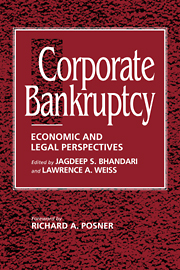Book contents
- Frontmatter
- Contents
- List of tables and figures
- Foreword by the HONORABLE RICHARD A. POSNER
- Preface
- Part I The role of credit
- 1 Leverage, Nobel Memorial Prize Lecture (1990)
- 2 Agency costs of free cash flow, corporate finance, and takeovers
- 3 A theory of loan priorities
- Part II Bankruptcy as a reflection of the creditors' implicit bargain
- Part III Beyond the basic creditors' bargain
- Part IV Workouts or bargaining in the shadow of bankruptcy
- Part V Alternatives to bankruptcy and the creditors' bargain
- Part VI Experience of other countries
- Index
3 - A theory of loan priorities
Published online by Cambridge University Press: 10 December 2009
- Frontmatter
- Contents
- List of tables and figures
- Foreword by the HONORABLE RICHARD A. POSNER
- Preface
- Part I The role of credit
- 1 Leverage, Nobel Memorial Prize Lecture (1990)
- 2 Agency costs of free cash flow, corporate finance, and takeovers
- 3 A theory of loan priorities
- Part II Bankruptcy as a reflection of the creditors' implicit bargain
- Part III Beyond the basic creditors' bargain
- Part IV Workouts or bargaining in the shadow of bankruptcy
- Part V Alternatives to bankruptcy and the creditors' bargain
- Part VI Experience of other countries
- Index
Summary
This article analyzes priorities among lenders in an insolvent debtor's personal property. Current law regulating these priorities rests on three priority principles: First, if the first creditor to deal with the debtor makes an unsecured loan, it shares pro rata with later unsecured creditors in the debtor's assets on default. Second, if this initial creditor makes an unsecured loan and a later creditor takes security, the later creditor has priority over the initial creditor in the assets subject to the security interest. Third, if the initial creditor makes a secured loan, it generally has priority over later creditors in the assets in which it has security.
There are several exceptions to this third principle of “first in time is first in right,” of which probably the most important is the purchase-money priority: A later creditor whose funds enable the debtor to purchase designated assets and who takes a security interest in these assets will have priority in them despite an earlier security interest that would otherwise have granted senior rank to the initial secured lender.
The legal rules that these three priority principles imply also hold independently of the contract between the initial financer and debtor. For example, if this creditor makes an unsecured loan but obtains from the debtor a covenant not to make future secured loans – a negative pledge clause – the covenant will not affect the debtor's power to grant security and, thus, senior rank to a subsequent lender.
- Type
- Chapter
- Information
- Corporate BankruptcyEconomic and Legal Perspectives, pp. 17 - 24Publisher: Cambridge University PressPrint publication year: 1996



